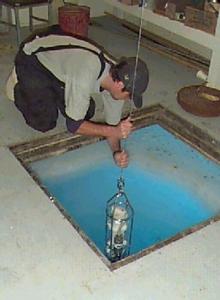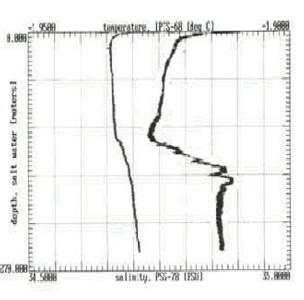5 December, 1996
This morning I went to collect CTD data with a scientist from New Zealand,
Miles LaMare. Miles, like the rest of his country mates I've met, is
especially friendly and will go out of his way to be helpful. Even though we
both speak English we seem to have a language barrier. I'm getting used to
his accent but I still have to listen carefully to understand him.
A CTD is a device that monitors and records the pressure, temperature, and
electrical conductivity of the water column as it is lowered from the
surface to the bottom. When the data is recovered, the depth of the probe is
calculated from the pressure on the sensor. The salinity is determined from
the conductivity. Most measuring device use this technique of indirect
measurement, a probe is designed which produces a voltage or current that is
proportional to the quantity of interest.
A computer chip records thousands of bits of data as the CTD is lowered.
When it is retrieved the data is down- loaded into a lap top computer where
it can be displayed in either tabular or graphical form. The graph is useful
because it aids in visualizing the structure of the water column. Miles is
interested in the water temperature because of the affect it has on the
fish. Small differences near the freezing point cause chemical changes in
the fish's blood, which keep ice crystals from growing. An ongoing study at
McMurdo is to try to investigate specific proteins that stick to ice
crystals that form in the cells of fish and keep them from becoming larger.
The graph shows data from a CTD cast that was taken very close to the
transition between the permanent ice shelf, which is about 100 feet thick,
and the 10-foot thick sea ice. It indicates that the water gets warmer below
100 feet and that the salinity increases. Warm water under cold is very
unusual in the ocean except in regions where there is sea ice.
In the open oceans, the water temperature decreases with depth. The upper
layers of water are heated by the sun and float on top of the colder more
dense water. Around Antarctica, when the water near the surface freezes, the
salinity of the remaining water increases. This warmer saline water is
denser than the colder water below and sinks. The sinking water causes the
bottom water to move up. The circulation brings nitrogen and phosphorous
(nutrients necessary for photosynthesis) from the benthos into the photic
zone. It also brings oxygen from the surface to the ocean depths. This
abundance of nutrients makes primary production especially high during
summer months. This bloom of phytoplankton has decreased the visibility in
the water to the point where normal dive operations have been halted.

Miles lowers a CTD through a hole in the ice.

A graph of temperature vs. depth plotted from CTD data shows that the water becomes warmer with increasing depth.
Contact the TEA in the field at
.
If you cannot connect through your browser, copy the
TEA's e-mail address in the "To:" line of
your favorite e-mail package.
|
